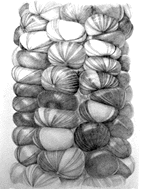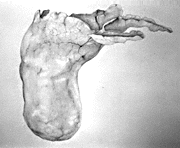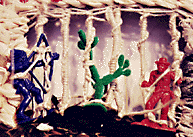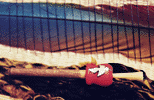Borders
![]() No. 39, Spring/Summer 1996
No. 39, Spring/Summer 1996
Borders
Words & Drawings by Matilda Essig / Weaving by Ann Keuper
Photographs by Merrill Parsons
 | Corn Pictured item contributed by Carlos Nagel, Friends of PRONATURA, Tucson. "Corn is the life stalk of our world, particularly since it is native to the central highlands of Mexico, symbolizing an important part of our survival. It has been a staple food for thousands of years of human civilization, transcending cultural limits through time." |
| Saguaro Boot Pictured item contributed by Wendy Burroughs, wildlife rehabilitator, Tucson. "When a bird pecks a nest hole into a saguaro, the cactus exudes a sap to wall off infection, which hardens into a solid structure - the boot. Started by flickers and woodpeckers, it will go on to house screech owls, kestrels, sparrows, cactus wrens, etc. When the saguaro dies and falls to the ground, cactus mice, snakes, insects, and scorpions will make their home inside." |  |
 | Key Pictured item contributed by Nereo de la Peña, painter and sculptor, Caborca, Sonora, Mexico. "A key for your tapestry, symbolizing confidence and friendship. |
| Cowboy and Indian Pictured item contributed by Anne Coe, artist, Apache Junction, Arizona. "These plastic toys represent the crazy funky real eccentric part of the west that is dying out as we get more urbanized." |  |
 | Starfish and Shells Pictured item contributed by Matilda Essig, artist, Tucson. "This starfish was washed up on the beaches of Puerto Peñasco after a violent storm. It symbolizes the wealth of marine life in the Sea of Cortez that is vitally connected to our desert ecosystem." |
| Feather and Peyote Pin Feather from a military macaw, a bird found in southeastern Sonora, northeastern Sinaloa and southwestern Chihuahua, Mexico. Peyote Pin was an anonymous contribution from a Native American. |  |
 | Beaded Turtle Pictured item contributed by Shelby Tisdale, anthropologist and museum consultant, Tucson. ...Made by an elderly Cocapah woman from the West Reservation outside of Somerton, Arizona. Turtles represent the Colorado River. It could also be representative of the desert tortoise. The beadwork is representative of the arts and crafts of the Cocopah in the U.S. and the Cucupa in Mexico." |
![]()
For more information about this project, contact Matilda Essig or Ann Keuper at:
1830 E. Broadway #109
Tucson AZ 85719 USA
520-620-2972
About the Arid Lands Newsletter